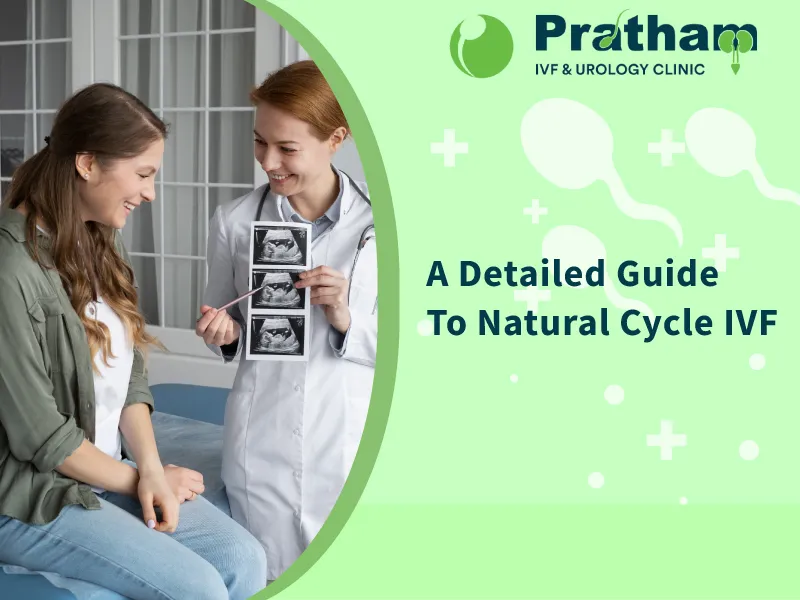
Natural Cycle IVF Treatment in Ahmedabad
Infertility treatments have evolved significantly, offering various options to help couples conceive. Among these, Natural Cycle IVF (NC-IVF) stands out as a less invasive and cost-effective alternative to traditional IVF. With traditional IVF, which involves stimulating the ovaries to produce many eggs, natural cycle IVF utilizes the body’s natural menstrual cycle to retrieve and fertilize a single egg. Pratham IVF Center specializes in providing natural cycle IVF treatment in Ahmedabad, providing high-quality fertility care designed to individual needs. This guide will cover the procedure, benefits, success rates, and considerations associated with Natural Cycle IVF.
What is Natural Cycle IVF?
Natural Cycle IVF is a specialized form of in vitro fertilization (IVF) that works in harmony with a woman’s natural fertility cycle. Rather than using hormone injections to stimulate multiple egg production, this approach focuses on retrieving the single egg that the body naturally selects during the menstrual cycle. This technique is ideal for women who prefer a more natural, medication-free approach or those with a history of poor response to ovarian stimulation.
The Natural Cycle IVF Procedure
Pratham IVF Center has an IVF specialist team that follows a step-by-step approach to ensure a successful natural cycle IVF treatment in Ahmedabad:
- Initial Consultation and Evaluation
The first step is a thorough evaluation of reproductive health, which includes reviewing medical history, conducting fertility tests, and discussing treatment options. Our fertility specialists assess factors like age, ovarian reserve, and overall health to determine if Natural Cycle IVF is the right choice.
- Monitoring the Menstrual Cycle
Since Natural Cycle IVF depends on precise timing, monitoring the menstrual cycle is crucial. This involves:
- Regular ultrasound scans
- Hormonal blood tests
- Identifying the optimal time for ovulation
- Egg Retrieval
Once the egg reaches maturity, the retrieval process is scheduled. This is a minimally invasive procedure performed under sedation, where a thin needle is used to extract the egg from the ovary. Since only one egg is retrieved, the process is simpler than traditional IVF.
- Fertilization
The recovered egg gets fertilized with sperm in a laboratory. Depending on sperm quality, intracytoplasmic sperm injection (ICSI) may be used to enhance fertilization chances.
- Embryo Transfer
Once the embryo reaches the ideal developmental stage, it is carefully transferred into the uterus using a catheter. This painless procedure does not require anesthesia.
- Pregnancy Test
Two weeks after the embryo transfer, a pregnancy test confirms whether implantation has occurred. If successful, early ultrasounds are scheduled to monitor pregnancy progress.
Benefits of Natural Cycle IVF
Natural Cycle IVF offers multiple advantages, making it a preferred choice for many couples at Pratham IVF Center:
- Reduced Medication Use - Unlike conventional IVF, which requires hormone injections, Natural Cycle IVF minimizes medication use, reducing the risk of Ovarian Hyperstimulation Syndrome (OHSS) and other side effects.
- Lower Cost - Since fewer medications and interventions are involved, Natural Cycle IVF Treatment in Ahmedabad is more affordable than traditional IVF, making it accessible to a wider range of patients.
- Less Invasive and More Natural - By working with the body’s natural cycle, the procedure is gentler, reducing stress and discomfort.
- Higher Quality Eggs - Natural Cycle IVF prioritizes the quality over quantity of eggs, which can be beneficial for women with a limited ovarian reserve but good egg quality.
- Reduced Risk of Multiple Pregnancies - Since only one embryo is transferred, the chances of multiple pregnancies are significantly lower, reducing associated health risks for both mother and baby.
Success Rates of Natural Cycle IVF
The success of Natural Cycle IVF varies based on individual factors such as age, egg quality, and overall health. On average, success rates range from 5% to 15% per cycle, but outcomes improve with repeated attempts.
-
Age Factor
- Women under 35 have higher success rates due to better egg quality.
- Women over 40 may experience lower success rates and require additional fertility support.
- Ovarian Reserve - A good ovarian reserve enhances success rates. Tests like AMH levels and antral follicle count help determine a woman’s fertility potential.
- Overall Health - Healthy lifestyle choices, proper nutrition, and stress management play a role in improving success rates.
Considerations and Limitations
While Natural Cycle IVF has numerous benefits, certain limitations must be considered:
- Lower Egg Yield - Since only one egg is retrieved per cycle, there is a lower chance of fertilization and implantation compared to conventional IVF, which retrieves multiple eggs.
- Not Suitable for All Women - Women with irregular menstrual cycles, low ovarian reserve, or severe fertility issues may not be ideal candidates.
- May Require Multiple Cycles - Success may take multiple attempts, which can extend treatment duration.
Why Choose Pratham IVF Center for Natural Cycle IVF Treatment in Ahmedabad?
Pratham IVF Center specializes in personalized fertility treatments designed to meet individual needs. Our experienced fertility specialists, advanced laboratory facilities, and patient-centered care ensure the highest standards in reproductive medicine.
Our Expertise Includes:
- Modern fertility treatments
- Minimal intervention approaches
- Affordable IVF solutions
- Holistic fertility care
If you are considering natural cycle IVF treatment in Ahmedabad, book an appointment with Pratham IVF Center today for a consultation. Our IVF specialist doctor is here to guide you on your journey to parenthood with safe, effective, and affordable fertility treatments
 Ahmedabad Top Rated IVF Center
Ahmedabad Top Rated IVF Center




